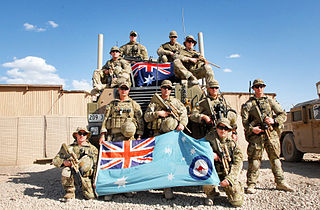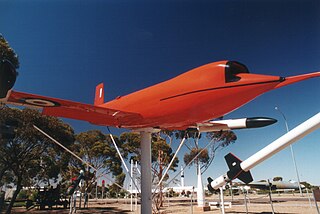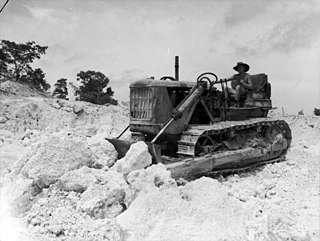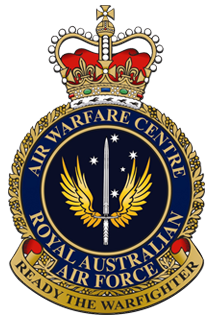Woomera originally refers to:

Airfield Defence Guards (ADG) are a mustering of the Royal Australian Air Force (RAAF) that are dedicated to the security and ground defence of airbases and other military aviation assets. Other duties include training other RAAF personnel, in skills such as the handling of small arms and infantry tactics. They do not, however, operate anti-aircraft artillery or missiles.

Woomera, unofficially Woomera village, refers to the domestic area of RAAF Base Woomera. Woomera village has always been a Defence-owned and operated facility. The village is located on the traditional lands of the Kokatha people in the Far North region of South Australia, but is on Commonwealth-owned land and within the area designated as the 'Woomera Prohibited Area' (WPA). The village is approximately 446 kilometres (277 mi) north of Adelaide. In common usage, "Woomera" refers to the wider RAAF Woomera Range Complex (WRC), a large Australian Defence Force aerospace and systems testing range covering an area of approximately 122,000 square kilometres (47,000 sq mi) and is operated by the Royal Australian Air Force.

RAAF Base Townsville is a Royal Australian Air Force (RAAF) air base located in Garbutt, 2 nautical miles west of Townsville in Queensland, Australia. It is the headquarters for No. 1 Wing Australian Air Force Cadets and, along with Lavarack Barracks, establishes Townsville as a key military centre. The base's airfield is shared with the Townsville Airport.
RAAF Base Edinburgh is a Royal Australian Air Force (RAAF) military airbase located in Edinburgh approximately 28 km (17 mi) north of Adelaide, South Australia, Australia and forms part of the Edinburgh Defence Precinct.

RAAF Williams is a Royal Australian Air Force (RAAF) military air base set across two locations, at Point Cook and Laverton, located approximately 20 km (12 mi) south-west of the Melbourne central business district in Victoria, Australia. Both establishments previously existed as separate RAAF Bases until 1989 when they were amalgamated to form RAAF Williams. The name was chosen in honour of Air Marshal Sir Richard Williams, the 'father' of the RAAF.
Jervis Bay Airfield is a military aerodrome in the Jervis Bay Territory in Australia. It is the only aerodrome in the territory and is located about 10 km (6.2 mi) east of Sussex Inlet; and about 2 km (1.2 mi) south of Jervis Bay Village and HMAS Creswell.

No. 20 Squadron is a Royal Australian Air Force (RAAF) support squadron. Coming under the control of No. 96 Wing, it is responsible for the management of the airfield at RAAF Base Woomera, South Australia. The squadron originated as a maritime patrol unit during World War II. Raised in August 1941, it operated PBY Catalina and Short Empire flying boats from bases in New Guinea, Queensland and the Northern Territory, conducting search-and-rescue, mine-laying, anti-submarine and bombing missions against Japanese targets in the Pacific theatre. Following the conclusion of hostilities, the squadron was disbanded in March 1946. It was reactivated as an airfield support squadron in April 2015.

Camden Airport is an aerodrome located on the outskirts of Sydney, 1 nautical mile northwest of Camden, New South Wales, Australia. The airport is located approximately 60 km (37 mi) from Sydney's central business district. Camden is used as a general aviation overflow airport for the busier Bankstown Airport, and provides facilities for gliding and ballooning. The aerodrome has one grass runway and one paved runway and two glider airstrips. It is in the south-west corner of the designated Sydney flight training area.

The GAF Jindivik is a radio-controlled target drone produced by the Australian Government Aircraft Factories (GAF). The name is from an Aboriginal Australian word meaning "the hunted one". Two manually-controlled prototypes, were built as the GAF Pika as a proof of concept to test the aerodynamics, engine and radio control systems, serialled A92-1/2, 'B-1/2'. The radio-controlled Jindivik was initially designated the Project B and received serials in the A93 series. Pika is an Aboriginal Australian word meaning flier.

Evans Head Memorial Aerodrome is a heritage-listed airport in Evans Head, Richmond Valley Council, New South Wales. The airport is approximately 1 km (0.62 mi) north of the village. During World War II it was Royal Australian Air Force (RAAF) Station Evans Head supporting RAAF No 1 Bombing and Gunnery School (1BAGS) and subsequently the RAAF No 1 Air Observers School. At the height of operations there were three asphalt runways and one grass strip. Only a single asphalt strip is still in use by private aviation. It was added to the New South Wales State Heritage Register on 22 November 2002.
Aitkenvale Aerodrome was an aerodrome located 10 km (6 mi) southwest of Townsville, Queensland, Australia near Aitkenvale Weir on the banks of the Ross River. It was also known as Weir and Aitkenvale Weir.
Bohle River Aerodrome was an aerodrome located 12.66 km (7.87 mi) west of Townsville, Queensland, Australia.

No. 5 Airfield Construction Squadron (5ACS) was a Royal Australian Air Force (RAAF) construction squadron. The unit was first formed in July 1942 and served in the New Guinea Campaign and Borneo Campaign during World War II. The squadron was one of only a few RAAF airfield construction units to be retained at the end of the war, and formed part of Australia's contribution to the occupation of Japan from 1945 until it was disbanded in June 1949. 5ACS was re-raised in August 1951 and worked on several RAAF airfields in Australia. It also provided small detachments of engineers to support RAAF deployments to South Vietnam and Thailand during the Vietnam War. The squadron was the RAAF's only airfield construction unit from 1961 onward, and was disbanded in December 1974.

Fairbairn, formerly RAAF Base Fairbairn, is a former Royal Australian Air Force (RAAF) military air base, located in Australia's national capital, Canberra, Australian Capital Territory. Over the years the name of the establishment, and the use of the land, has changed. The base was in use by the RAAF between 1940 and 2007, when the land occupied north and east of the Canberra Airport runways was sold to Capital Airport Pty Limited for the purposes of advancing civil aviation and the development of a business park.
The Oaks Airfield is an unlicensed private airfield located in The Oaks, New South Wales, in the Wollondilly Shire, west of Sydney, Australia. Originally built by the Royal Australian Air Force (RAAF) during World War II, today the airfield caters mostly to recreational aircraft and flight training and is home to Dave's Flying School and the Sydney Recreational Flying Club. The airfield is a heritage listed site and is the only airport constructed during WWII to still be operational. Other airfields from the time in Sydney have either being converted or demolished.

The RAAF Woomera Range Complex (WRC) is a major Australian military and civil aerospace facility and operation located in South Australia, approximately 450 km (280 mi) north-west of Adelaide. The WRC is operated by the Royal Australian Air Force (RAAF), a division of the Australian Defence Force (ADF). The complex has a land area of 122,188 km2 (47,177 sq mi) or roughly the size of North Korea or Pennsylvania. The airspace above the area is restricted and controlled by the RAAF for safety and security. The WRC is a highly specialised ADF test and evaluation capability operated by the RAAF for the purposes of testing defence materiel.

The Bore Sight Range and Compass Swinging Platform are a heritage-listed pair of aircraft testing facilities at Charters Towers Airport, Charters Towers, Charters Towers Region, Queensland, Australia. They were built from 1942 to 1943. They are also known as Charters Towers WWII Airfield Gun Firing Range and Compass Swinging Station. They were added to the Queensland Heritage Register on 14 May 2010.

The Air Warfare Centre (AWC) is a Force Element Group of the Royal Australian Air Force (RAAF) based at RAAF Base Edinburgh. It was formerly titled the Aerospace Operational Support Group (AOSG) and was reformed into the AWC in 2016.














